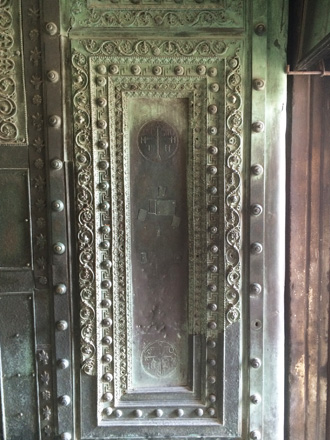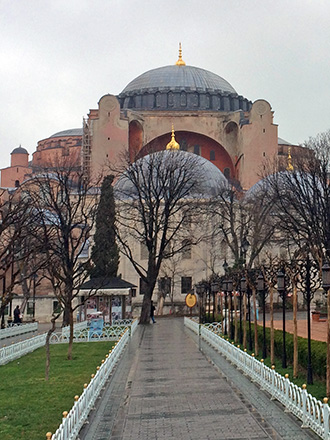Hagia Sophia |
||
Hagia Sophia was built about 1,500 years ago in Constantinople (earlier known as Byzantium, now known as Istanbul), which was then the capital of the Roman Empire, and today thrives as the largest city in Turkey. Before the construction of the current Hagia Sophia, there had been two previous churches that existed at the same site, but they were destroyed in riots and fires. Notably, in the Nika riots of 532 AD, an earlier Hagia Sophia church on the site of the current edifice was burned to the ground. Thus, after the Nika riots, which had been a serious threat to his continued rule, the Eastern Roman Emperor Justinian I gave an order to reconstruct a third church on the same spot as the preceding two churches. The architects who were chosen to design the new church were Greek engineers with backgrounds in physics and mathematics: Isidore of Miletus and Anthemius of Tralles. It took six years and ten thousand workers to complete this large-scale construction. It was the largest church in the world for more than 1,000 years until 1519, when the Seville Cathedral in Spain earned the title. At the time of the Hagia Sophia's construction in the 530s, Constantinople (now Istanbul) was probably the largest and most sophisticated city on the planet. Its rivals would have been Teotihuacan in Mexico, which was then declining; Ctesiphon, the capital of the Sasanian Persian Empire; and Chang'an, Luoyang, and Nanjing, the capitals for various factions and families that claimed power during the turbulant 6th century Southern & Northern dynasty period in China. When the Hagia Sophia was constructed in Constantinople, that city was the capital of the Roman Empire, and had been since Constantine the Great moved the capital there in 330, yet it was a Greek city and its inhabitants were more likely to speak Greek rather than Latin. Back in Rome, the Italian Peninsula was the battleground of the Gothic war, in which armies commanded from Constantinople defeated the Ostrogothic Kingdom, and then came the invasion of the Lombards, who displaced Constantinople's power in Italy. So, the city of Rome was not so important, but Constantinople was. Constantinople had been known as Byzantium, and had been an important Greek city for centuries before Constantine moved the imperial capital there in 330. Constantine transferred power from Rome to Byzantium so he could build his “New Roman” empire away from the corruption of Roman political life. Byzantium was then renamed as Constantinople. The Eastern Roman empire continued to adopt Greek language, culture, and one of the main Christian denominations—Greek Orthodox Christianity. But the turmoil that had cursed Rome arose again in Constantinople, as political and religious factions split the city over time and riots and violent intrigues plagued the Roman Empire in Constantinople. At the beginning of this new Roman age in the Greek areas of the Eastern Mediterranean, Emperor Constintine had not made a clear distinction between the monotheistic Christianity he eventually embraced and the older polytheistic Greek and Roman traditions. “Sophia” in Greek means "Wisdom" and the church is now dedicated to God in God’s attribute of Holy Wisdom, but when the first Hagia Sophia church was originally dedicated in 360 by Emperor Constantine (who ordered its construction in 325), it was a place of worship for Christians who honored the Christian God while its emphasis on an aspect of God (wisdom) may have made it more attractive to more traditional pagans who had worshiped a Goddess of Wisdom Minerva (or Athena in Greece) at an older temple that had stood on the same site. Although earlier versions of the Hagia Sophia were burned down in 404 and 532, the church completed in 537 has remained standing until today, although it needed major reconstruction and renovations after the earthquake of 558 and 869, with further work to repair and stabilize the structure undertaken in 989, 1317, 1344, and finally in 1847-49. In 1453 the Ottoman Turks invaded Constantinople successfully and moved their empire's capital from Edirne to Constantinople. The new ruler, Sultan Mehmet II, gave an order of converting the Hagia Sophia from a Christian church into a Mosque. Today this building has a mixture of characteristics from Christianity and Islam in its interior and exterior. Constantinople, a city stretching across both Asia and Europe was renamed to Istanbul in 1923 when the Republic of Turkey moved its capital away to Ankara. Interiors with images: Great dome: The Traditional Roman Dome is built on a circular base, while a rectangular Christian church usually follows typical Basilica-style architecture. When Emperor Justinian I gave an order to build a new church, he requested a combination of both Roman dome and Basilica structures to show his prestige. This unprecedented building was a difficult challenge indeed, yet the whole thing was finished in about five years. On a geometric two-dimensional plane, a circle will fit in a square with four equal sides. Thus, the dome of Hagia Sophia is built on a square base. Now imagine a three-dimensional blueprint of this structure: a dome supported by arches on all four sides of a square base. To support this massive, heavy object, these arches must be equilateral to the sides of the square base, but they are still not enough to support this large, thick dome. Therefore, the architects designed four buttress pillars on the corners of the four arches and two semi domes on the sides to push the structural force inward. At the end of this design is the pendentive where the corners of the square and arches are filled. After the consolidation of this place, the great dome is held up 180 feet high. Today, the great dome in Hagia Sophia is not the original as it was destroyed in an earthquake 20 years after it was built in 558. Architect Isidoro El Joven (Isidor the Younger) was given the mission to build a new dome. The difference in the new design is that 40 windows are now installed inside the dome. Their function is to not only increase the light inside the building, but also to reduce the weight of the dome itself to help it survive any earthquakes in the future.
Back to the World History Timeline in English Back to the Historylines home page. Articles of French history:Eiffel tower, Louvre, Versailles, Notre-Dame de Paris, Paris Opera house. Articles of Chinese history: oil well, abacus, compass, gunpowder, first dictionary, paper money, wheelbarrow
|
 Two-winged bronze door Two-winged bronze door  pathway approaching the Hagia Sophia pathway approaching the Hagia Sophia
|